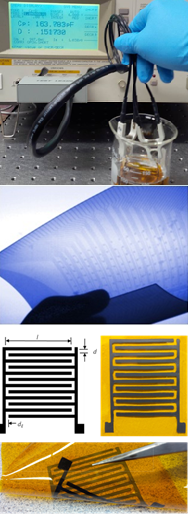
Stretchable Electronics and Biosensors

Stretchable electronic circuitry and biosensor arrays will significantly impact the future of bionics, neural interfaces, wearable sensors and displays, wireless RF tags and sensors, and environmental monitoring sensor arrays. Recent advances in printing technologies and electrically conductive inks have enabled microelectrodes and simple electronic circuits to be fabricated on mechanically flexible polymers, paper, and textiles. Electrode arrays and circuits built on stretchable substrates (eg. PDMS, elastic sheets) are, however, far more difficult to achieve because the conductive material must absorb large levels of strain without fracturing or degrading the electronic properties.
Recent advances in electrically conductive inks have encouraged researchers at Western to explore drop-on-demand printing as a viable approach to creating conductive traces, electrodes, and functionalized circuits on a variety of non-rigid substrates. The research explores drop-on-demand fabrication and laser micromachining methods to print and locally “tune” the electrical, optical and mechanical properties of graphene-based microstructures; exploit the principles of mechanical design to enhance the functionality (electrical & optical properties) and stretchability of electrodes and interconnects printed on various flexible substrates (polymers, paper, textiles); establish methods and guidelines for bio-functionalizing mechanically flexible printed circuits.
Collaborating Researcher: Dr. Suwas Nikumb (NRC-IMI, London)